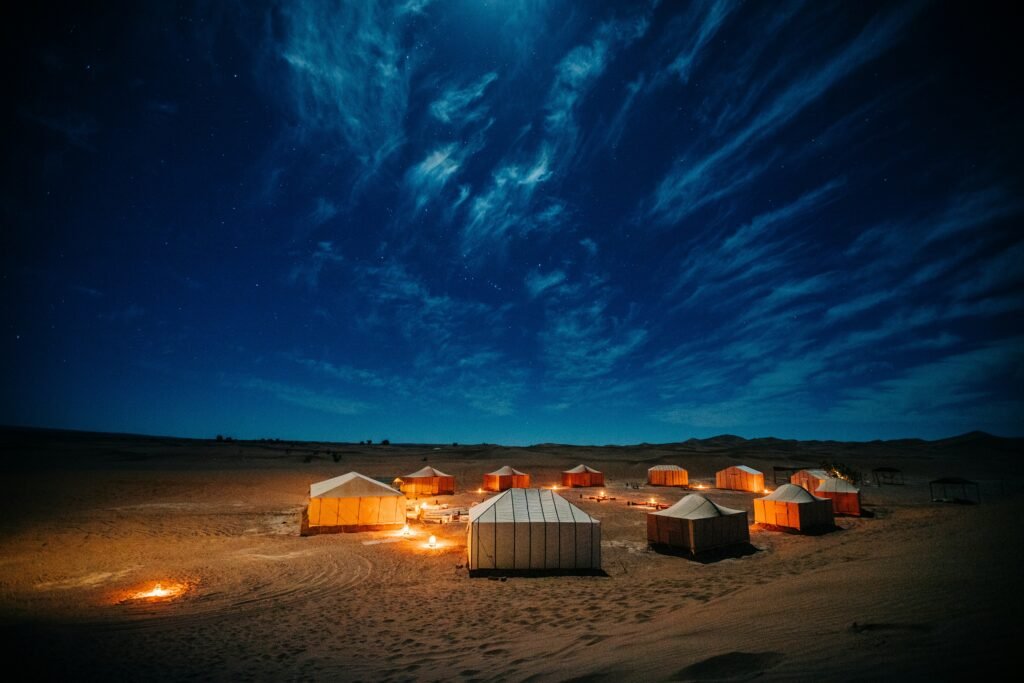Table of Contents
Introduction
The vast, undulating dunes of the Moroccan Sahara have long captured the human imagination, transforming Moroccan Sahara tourism into a testament of ever-changing landscapes and timeless stories. From the whispered legends of ancient caravans to the modern pulse of organized tours, the evolution of Moroccan Sahara tourism weaves a narrative of adventure, resilience, and transformation. This article unfolds the remarkable journey of desert tourism in this region through four distinct chapters, each echoing the enduring allure of the desert.
Early Explorations and Perceptions

Long before modern Moroccan Sahara tourism emerged, intrepid explorers and wandering traders were drawn to the mystique of the Moroccan Sahara. In those early days, the desert was more than a barren wasteland—it was a realm of enchantment, fraught with both peril and promise. Travelers recounted encounters with endless seas of sand that seemed to ripple like golden waves under the relentless sun. Their journals, filled with poetic musings and vivid sketches, laid the foundation for what would become organized Moroccan Sahara tourism.
These early visitors were not mere tourists but seekers of knowledge and experience. They encountered the indigenous populations, whose deep-rooted connection with the land was palpable in every gesture and word. The nomadic tribes, with their storied traditions and quiet wisdom, opened a window into a way of life that was intimately tied to the rhythms of nature. Rather than imposing their own views, these visitors often listened in awe as local guides explained the silent language of the dunes and the secret lore of desert stars.
The perceptions of the Moroccan Sahara during these times were imbued with both reverence and apprehension. The harshness of the environment was a constant reminder of nature’s indomitable power, yet within that harshness lay a profound beauty—an allure that defied the simplicity of survival. The early explorers documented not only the physical challenges of desert life but also the transformative encounters that reshaped their inner worlds. Every step taken on the scorching sands was a step into the unknown, where legends came alive and every sunset promised a new revelation.
The Rise of Organized Tourism

As centuries passed, the allure of the Moroccan Sahara continued to captivate, yet the nature of exploration began to shift. Traditional Moroccan Sahara tourism started taking shape as isolated wanderings gradually gave way to more structured and accessible forms of desert exploration. With the construction of roads that cut through the vast expanses of sand and the establishment of accommodations that offered respite from the relentless heat, the desert began to welcome visitors in a new, organized manner.
The mid-20th century marked a turning point when tour operators saw the potential in the mystique of the Sahara and began crafting itineraries that balanced adventure with comfort. The once impassable dunes were slowly tamed by the steady progress of human ingenuity—motorized vehicles, well-marked trails, and established campsites transformed the desert from an enigmatic wilderness into a well-charted realm of exploration. Travelers no longer needed to brave the perils of isolation alone; they could now venture into the Moroccan Sahara with a guide, a map, and the promise of a safe journey.
In parallel, the Moroccan government played a pivotal role in this transformation. Recognizing the potential for tourism to stimulate local economies and foster cultural exchange, state initiatives were launched to promote the Moroccan Sahara as a premier destination. Infrastructure improvements were coupled with marketing campaigns that painted a picture of an exotic, yet hospitable, landscape. Efforts were made to preserve the delicate balance between development and the natural beauty of the desert, ensuring that while the number of visitors grew, the spirit of the Sahara remained intact.
This era of organized tourism brought with it a renaissance of interest in the desert’s rich cultural heritage. The old tales of caravans and ancient trade routes were reimagined for a modern audience, blending history with the thrill of discovery. Travelers were drawn not only by the promise of adventure but also by the opportunity to immerse themselves in a landscape where every grain of sand held centuries of stories.
Key Destinations and Activities

Today, Moroccan Sahara tourism offers a mosaic of experiences that continue to enchant visitors from around the world. Among the myriad attractions, the legendary Erg Chebbi stands out with its towering dunes that stretch toward the horizon like nature’s own sculptures. Modern Moroccan Sahara tourism has transformed these natural wonders into accessible destinations where the dance of light and shadow creates an ever-changing panorama, a spectacle that invites both awe and introspection. In the nearby town of Merzouga, the pulse of desert life beats in rhythm with ancient traditions—camel treks lead travelers deep into the heart of the dunes, where nights are illuminated by a celestial tapestry unlike any other.
Further along the sandy trails, places like Zagora and Dakhla reveal their own unique charms. Zagora, with its storied kasbahs and narrow alleys, offers a glimpse into a bygone era, where the remnants of ancient fortresses stand as silent witnesses to centuries of history. Dakhla, renowned for its water sports, especially kitesurfing, represents the modern fusion of adventure and leisure. Here, the desert meets the Atlantic, and the play of wind and water creates a dynamic setting for both thrill-seekers and those in search of tranquil beauty.
The Moroccan Sahara is also a place where cultural encounters are as varied as the landscapes. Visitors find themselves welcomed by local nomads, whose hospitable traditions and vibrant storytelling bring the desert to life. In intimate gatherings around a crackling fire, travelers listen to tales spun from the threads of ancestral memory—a living tapestry of folklore and ritual. These encounters are not just about witnessing a culture; they are about experiencing it firsthand, learning the nuances of desert life and forging bonds that transcend the boundaries of language and time.
Activities in the Moroccan Sahara cater to a spectrum of interests. For those seeking to reconnect with nature, desert camping offers an intimate communion with the elements, where the silence of the dunes is punctuated only by the whisper of the wind. For the adventurous at heart, excursions by four-wheel drive across rugged tracks reveal hidden oases and secret valleys, each one a promise of discovery and wonder. Whether it is the thrill of riding a camel across endless sands or the meditative calm of a starlit night, the Moroccan Sahara invites every traveler to craft their own story in its vast, timeless expanse.
Impacts and Future of Saharan Tourism

The transformative journey of Moroccan Sahara tourism has not been without its challenges. The influx of visitors has undoubtedly brought economic opportunities to local communities, sparking a revival of traditional crafts and entrepreneurial ventures. Sustainable Moroccan Sahara tourism remains a priority as the delicate balance between growth and preservation continues to shape development decisions.
Socially, the evolution of tourism has fostered a dynamic exchange between the modern world and ancient traditions. Locals now find themselves as both guardians of cultural heritage and participants in a global dialogue, where the stories of the Sahara are shared with an international audience. This cultural interplay has enriched both the visitors and the hosts, creating a symbiotic relationship that highlights the resilience of desert communities.
Economically, tourism has become a lifeline for many in the region. Government initiatives aimed at sustainable development have not only improved infrastructure but also enhanced the quality of life for those living in and around the desert. Investments in eco-friendly accommodations and community-based tourism projects have emerged as beacons of progress, demonstrating that economic growth need not come at the expense of the environment.
Looking to the future, the Moroccan Sahara stands at a crossroads where tradition meets modernity. The challenges of climate change, resource management, and over-tourism call for innovative approaches to ensure that the desert’s beauty endures for generations to come. Sustainable tourism initiatives are gaining momentum, with a focus on reducing environmental footprints, promoting local craftsmanship, and preserving the cultural integrity of the region.
Efforts by the Moroccan government continue to be instrumental in shaping this future. Policies that encourage eco-tourism and responsible travel are being implemented with the aim of protecting the natural and cultural treasures of the Sahara. These initiatives are not merely about preserving a landscape but about nurturing a legacy—a promise that the wonders of the Moroccan Sahara will continue to inspire and captivate long after the footsteps of today’s travelers have faded into the sands of time.
Conclusion
The story of Moroccan Sahara tourism is one of evolution, where ancient paths have given way to modern highways, and solitary wanderings have blossomed into organized adventures. It is a narrative of transformation that echoes the spirit of the desert—a spirit that is both timeless and ever-changing. From the early explorers whose hearts beat in rhythm with the shifting dunes to the modern traveler who seeks both thrill and introspection, responsible Moroccan Sahara tourism remains a testament to the enduring allure of nature’s most enigmatic realm.
In embracing its past and looking toward a sustainable future, the Moroccan Sahara continues to offer a unique tapestry of experiences. Each grain of sand, each starry night, and every whispered legend serves as a reminder of the beauty and resilience that define this majestic desert. As we step forward into new chapters of discovery, the evolution of tourism here stands as an invitation—a call to wander, to learn, and to marvel at the boundless wonders of the world.



